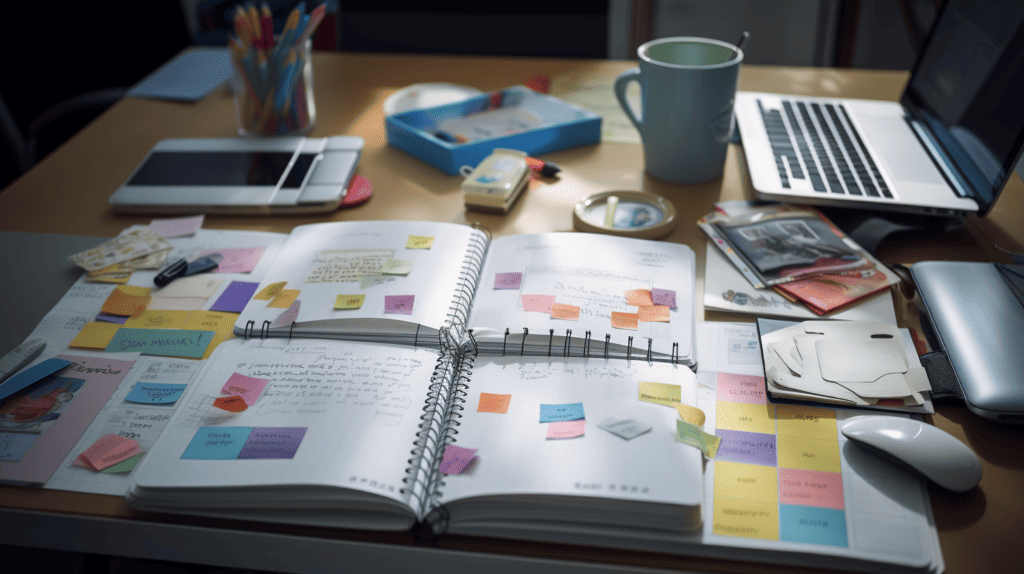Welcome to my article on time management strategies for reading! As a copywriting journalist, I understand the importance of maximizing productivity and efficiency, particularly when it comes to reading. Whether you’re a student, a professional, or simply an avid reader, implementing effective time management techniques can greatly enhance your reading habits and improve your overall learning experience.
In this section, we will explore various time management strategies specifically tailored for reading. By prioritizing tasks, creating an optimal reading schedule, and implementing techniques such as time blocking and speed reading, you can transform your reading habits and become a more efficient reader. Let’s get started!
Key Takeaways:
- Effective time management techniques can greatly enhance your reading habits and improve your overall learning experience
- Prioritizing tasks and creating an optimal reading schedule are key to maximizing productivity and efficiency
- Implementing techniques such as time blocking and speed reading can help you become a more efficient reader
Prioritize Your Reading Tasks
As an avid reader, it’s easy to get overwhelmed by a never-ending list of books, articles, and research papers. To make the most of your reading time, it’s crucial to prioritize your tasks and focus on the materials that are most important to you.
One effective method for prioritizing your reading tasks is to categorize them based on urgency and importance. This can be done using a simple grid with four quadrants, with urgency on the x-axis and importance on the y-axis. This way, you can easily identify which materials require your immediate attention and which can be saved for later.
| Important | Not Important | |
|---|---|---|
| Urgent | Quadrant 1: Prioritize these tasks and complete them as soon as possible. | Quadrant 3: Delegate or eliminate these tasks if possible. |
| Not Urgent | Quadrant 2: Schedule time to complete these tasks when they become urgent. | Quadrant 4: These tasks can be saved for later or eliminated. |
Besides urgency and importance, you can also prioritize your reading tasks based on your personal interests and goals. For example, if you’re interested in learning a new skill, prioritize reading materials related to that skill to achieve your goal faster.
Conclusion
Prioritizing your reading tasks is an essential step in mastering time management strategies for reading. By categorizing your materials based on urgency, importance, and personal interests, you can focus your attention on the most valuable and relevant materials, and optimize your reading time accordingly.
Create an Optimal Reading Schedule
In order to maximize our reading efficiency, it’s important to have a well-planned reading schedule. Here are a few tips to create an optimal reading schedule:
- Identify your most productive reading time: Everyone has different times of the day when they are most alert and focused. Identify your personal peak times and schedule your reading during those hours.
- Break it up: Reading for long stretches of time can lead to burnout and decreased productivity. Break your reading sessions into shorter, more manageable intervals.
- Set specific reading goals: Having a clear goal in mind can help motivate and guide your reading sessions. Decide on the amount of material you want to cover, and set a specific timeframe to achieve your goal.
By creating an optimal reading schedule, you can ensure that you are utilizing your time effectively and making the most of your reading sessions.

Time Blocking for Reading
Time blocking is an excellent method for managing your reading time effectively. By allocating specific time slots for reading, you can minimize distractions and ensure that you stay on track with your reading goals.
To begin with, select a time block that suits your schedule. This could be a 30-minute block in the morning or a 60-minute block before bed, depending on your availability and preferences.
Once you have a time slot, prioritize your reading materials for that block. For instance, if you’re reading a book, set a target for the number of pages to be read during the time block. Alternatively, if you’re reading articles, select the ones that are most relevant or pressing.
During the time block, focus solely on reading and avoid multitasking. Put your phone on silent or airplane mode, close any unnecessary tabs, and create a conducive reading environment.
After the time block ends, take a short break before beginning another task. This break helps to refresh your mind and create a clear break between tasks.
Overall, time blocking is an effective way to manage your reading time, minimize distractions, and increase your reading productivity.
Prioritize Book Selection
When it comes to reading, it’s essential to prioritize your book selection based on your goals and interests. With so many options available, selecting the right book can make all the difference in maximizing your reading time.
Here are some tips to help prioritize your book selection:
- Identify your reading goals and interests. Are you looking to learn a new skill or gain knowledge in a specific field? Are you interested in fiction or non-fiction?
- Research books that align with your goals and interests. Look for recommendations from trusted sources or online reviews.
- Consider the length and complexity of the book. If you have limited time, choose a shorter or more straightforward book to tackle first.
- Don’t be afraid to abandon a book that doesn’t hold your interest. Life is too short to read books that don’t captivate you.
- Set aside time for leisurely reading. Don’t forget to prioritize fun and enjoyable reading materials as well.
By prioritizing your book selection, you can ensure that your reading time is spent on valuable and enjoyable material that aligns with your goals and interests.

Avoid Distractions While Reading
Distractions can be a major obstacle to efficient reading. When I’m trying to focus on a book or article, any little disturbance can quickly throw me off track. Here are some practical methods I use to minimize distractions and create a conducive reading environment:
Create a quiet space
Find a quiet place to read where you won’t be constantly interrupted. If you don’t have a private space, consider using noise-cancelling headphones or earplugs to block out surrounding sounds.
Turn off your phone and notifications
Your phone can be a major source of distraction. To eliminate this problem, turn it off or put it on silent mode during your reading time. If you need your phone for reference, switch off notifications and avoid checking social media or email.
Use a distraction-blocking app
There are several helpful apps that can block distracting websites and applications during your reading time. Some popular examples include Freedom, Cold Turkey, and RescueTime.
Take a break if needed
If you find yourself getting too distracted, take a break and come back to your reading later when you can focus better.
By implementing these strategies, you can create a peaceful and productive reading environment, allowing you to fully engage with the content at hand.
Speed Reading Techniques
Reading quickly doesn’t mean sacrificing comprehension. There are several speed reading techniques that can help you read faster while maintaining retention and comprehension. Here are some tips to get started:
- Eliminate subvocalization: This is the habit of “saying” each word in your head as you read. Practicing reading without subvocalizing can help increase your reading speed
- Scanning: This involves quickly scanning through the text to identify key words and phrases. This technique can be useful for previewing material before diving deeper
- Chunking: This involves grouping words together instead of reading them individually. If you can train your brain to quickly identify groups of words, you can read more quickly without sacrificing comprehension
“Reading is to the mind what exercise is to the body.” – Joseph Addison
Remember, speed reading is a skill that takes practice to master. Be patient with yourself and try to incorporate these techniques into your regular reading practice. With consistent practice, you can increase your reading speed and improve overall productivity.

Maximize Reading Productivity
Improving your reading productivity is about more than just reading faster. Here are some tips and strategies to help you get the most out of your reading time:
- Active reading: Engage with the material actively, asking questions and making connections to enhance understanding and retention.
- Note-taking: Take concise notes to summarize key points and ideas. This not only helps with retention but also serves as a useful reference when revisiting the material.
- Utilizing technology: Take advantage of various reading apps and tools that can help enhance your reading experience, such as Readwise, which organizes your highlights and notes for easy access, and Kindle’s X-Ray feature that allows you to quickly access character and plot information.
Incorporating these techniques can help you maximize your reading productivity by improving comprehension and retention, as well as streamlining your reading process.
Implement Time Management Tools
As a professional copywriting journalist, I rely heavily on time management tools to help me stay organized and productive. Whether you prefer mobile apps or desktop software, there are numerous options available to help you manage your reading time effectively.
One of my favorite time management tools is RescueTime, which tracks your reading time and provides detailed reports on how you spend your time. This tool allows you to set goals and monitor your progress, helping you stay on track with your reading goals.
| Time Management Tool | Description |
|---|---|
| Forest | This mobile app uses a gamification approach to help you stay focused while reading. The app encourages you to stay off your phone while reading by planting a virtual tree, which grows as you read. |
| Trello | A popular project management tool that can be customized for reading tasks. You can create lists for books to read, reading goals, and schedule reading time on the calendar. |
Another useful time management tool is Google Calendar, which can help you create a structured reading schedule. You can block out specific times for reading, set reminders for reading sessions, and integrate the calendar with other productivity tools.
Remember, time management tools are meant to be a helpful aid, not a distraction. Experiment with different tools to find what works best for you and your reading habits.

Track and Analyze Your Reading Habits
Tracking and analyzing your reading habits can provide invaluable insights into your productivity and help you make informed decisions about your reading schedule and material selection.
Personally, I use a reading log to track the number of pages or chapters I read each day, as well as the time of day and location where I read. This helps me identify patterns in my reading habits and adjust my schedule accordingly.
You can also use various apps and software programs to track your reading habits automatically, such as Goodreads or Readwise. These tools provide detailed analytics on your reading history, including your reading speed and the genres or authors you read most frequently.
It’s essential to regularly review and analyze your reading habits to ensure that you’re making progress towards your goals and maximizing your efficiency. By doing so, you can make informed decisions about your reading material and schedule, ensuring that your time spent reading is meaningful and productive.
Seek Accountability and Support
Staying accountable and motivated in your reading habits can be challenging, but seeking support and accountability can make all the difference. Here are some ways to get the support you need:
- Join a book club or reading group to discuss books and stay motivated.
- Set up a reading challenge with friends or family to encourage one another.
- Use social media to connect with like-minded readers and share your progress.
- Consider hiring a reading coach or accountability partner to provide personalized support and guidance.
Whatever method you choose, having a support system in place can help you stay on track and achieve your reading goals.

Put It All Together
Mastering time management strategies for reading can revolutionize your learning experience and transform your reading habits. By applying the techniques discussed in this article, you can improve your reading efficiency, prioritize your reading tasks, and create an optimal reading schedule. Take advantage of time blocking for reading, select books that align with your goals and interests, and minimize distractions while reading. Implement speed reading techniques to enhance your reading speed and comprehension, and utilize technology tools to maximize your reading productivity.
Track and Analyze Your Progress
Tracking your reading habits is a crucial part of optimizing your time management strategies. By recording your progress, you can identify patterns, strengths, and areas for improvement. You can also use the data to adjust your reading schedule and track your progress towards your reading goals. Analyzing your reading habits enables you to identify the most effective time management strategies for your learning style and lifestyle.
Seek Accountability and Support
Having accountability and support systems in place can help you maintain consistent reading habits. Find a reading buddy, participate in a book club, or seek professional help from a reading coach or mentor. These resources can help you stay motivated and accountable for your reading goals.
Conclusion on Time Management Strategies For Reading
Transforming your reading habits through effective time management strategies can unlock your full reading potential and improve your overall learning experience. By prioritizing tasks, creating an optimal reading schedule, and implementing various techniques, you can revolutionize the way you read. Apply these strategies today and start maximizing your reading productivity. Happy reading!
FAQ on Time Management Strategies For Reading
Q: What are some effective time management strategies for reading?
A: Effective time management strategies for reading include prioritizing your reading tasks, creating an optimal reading schedule, utilizing time blocking techniques, prioritizing book selection, avoiding distractions, and implementing speed reading techniques.
Q: How can I prioritize my reading tasks?
A: Prioritizing your reading tasks involves assessing the importance and urgency of each task, setting realistic goals, and allocating time accordingly. It is helpful to categorize your reading materials and prioritize based on deadlines, relevance, and personal preferences.
Q: How do I create an optimal reading schedule?
A: To create an optimal reading schedule, consider your daily routines and commitments, determine your peak reading times, allocate dedicated reading slots, and set specific goals for each reading session. Experiment with different schedules to find what works best for you.
Q: What is time blocking for reading?
A: Time blocking for reading is a technique where you allocate specific time slots solely for reading. By dedicating uninterrupted blocks of time, you can focus on your reading materials without distractions and improve your overall reading efficiency.
Q: How can I prioritize my book selection?
A: Prioritizing book selection involves identifying your reading goals, interests, and preferences. Consider the relevance of the book to your current needs, reputation and recommendations, professional or personal growth potential, and the overall value it will bring to your reading experience.
Q: How can I avoid distractions while reading?
A: To avoid distractions while reading, find a quiet and comfortable reading environment, minimize external noise, put away electronic devices or use apps that block distractions, and develop strategies to stay focused, such as setting specific reading goals or using noise-canceling headphones.
Q: What are some speed reading techniques?
A: Speed reading techniques include using your hand or a pointer to guide your eyes, practicing skimming and scanning techniques, increasing reading pace gradually, focusing on important keywords or phrases, and utilizing visualization or mind mapping methods to improve reading speed and comprehension.
Q: How can I maximize my reading productivity?
A: To maximize your reading productivity, employ active reading techniques such as highlighting or taking notes, engage in pre-reading and post-reading exercises, practice effective note-taking methods, utilize technology tools like e-readers or annotation apps, and maintain a growth mindset towards continuous improvement.
Q: What time management tools can I use for reading?
A: There are various time management tools and apps available to help streamline your reading process, such as task management apps, Pomodoro timers, digital reading organizers, speed reading apps, and note-taking tools. Experiment with different tools to find ones that suit your needs and preferences.
Q: How do I track and analyze my reading habits?
A: To track and analyze your reading habits, maintain a reading log or journal, record the number of pages or books read, track reading time, identify patterns or trends in your reading behavior, review your progress regularly, and use apps or spreadsheets to visualize your data and gain insights into your reading habits.
Q: How can I seek accountability and support for my reading goals?
A: Seek accountability and support by joining book clubs or reading groups, finding an accountability partner, participating in online reading challenges or forums, sharing your reading progress on social media, or seeking guidance from a reading coach or mentor. Surrounding yourself with like-minded individuals can help you stay motivated and accountable for your reading goals.





Leave a Reply